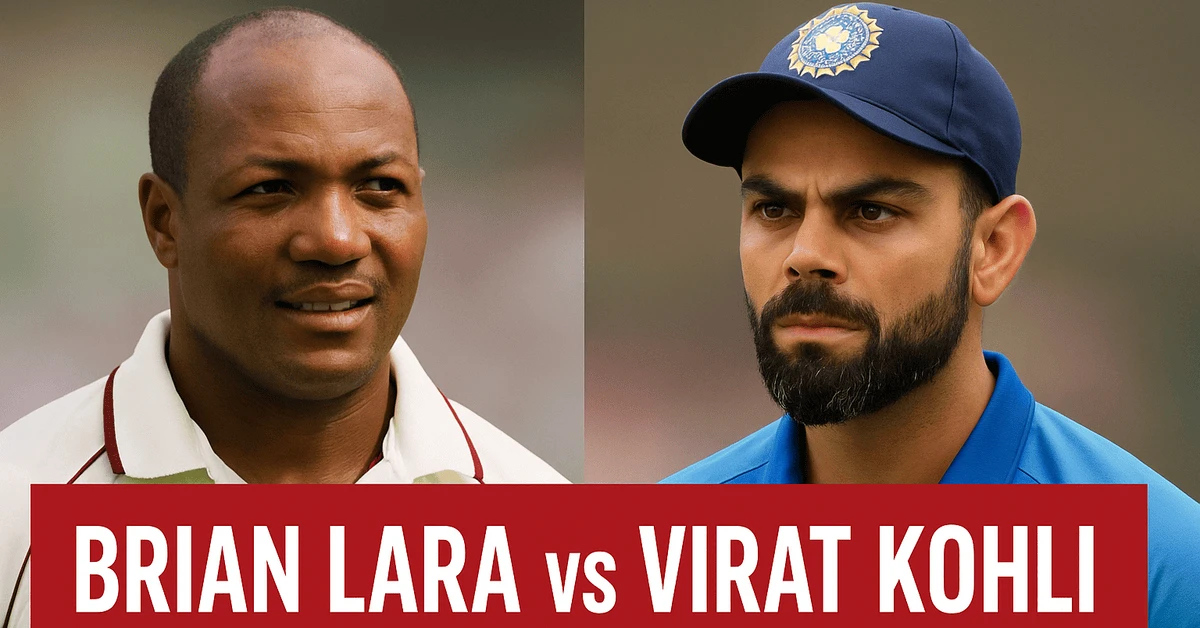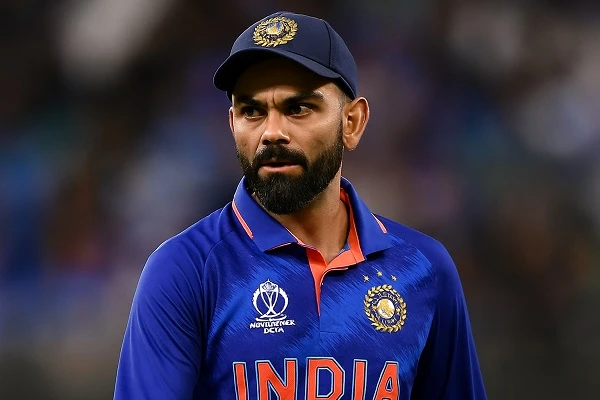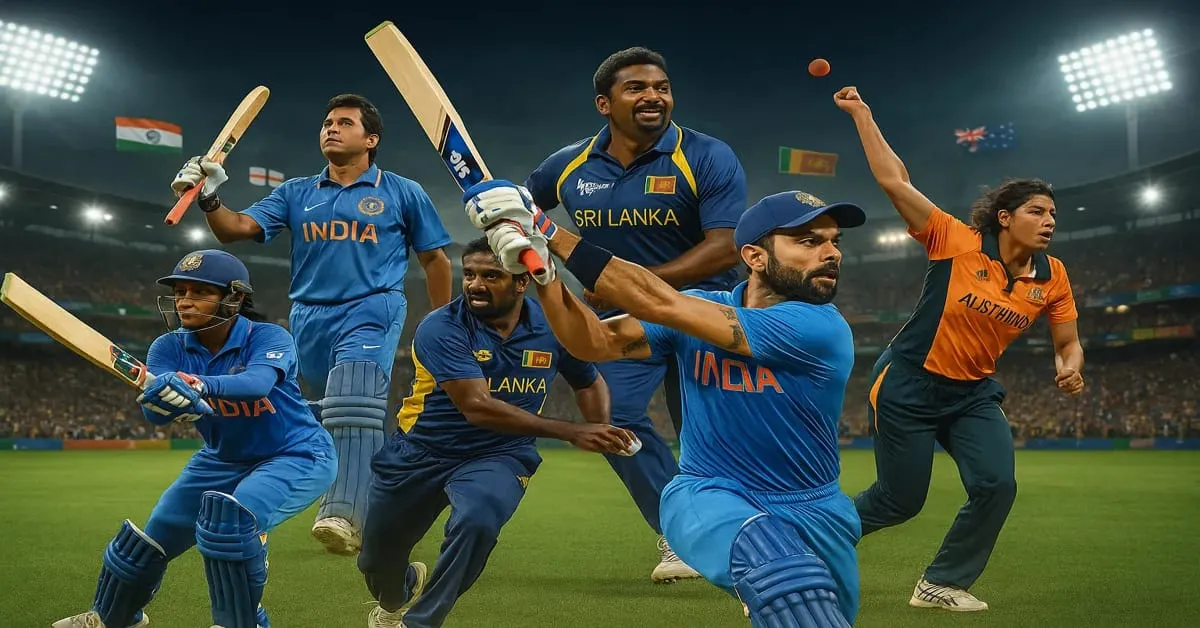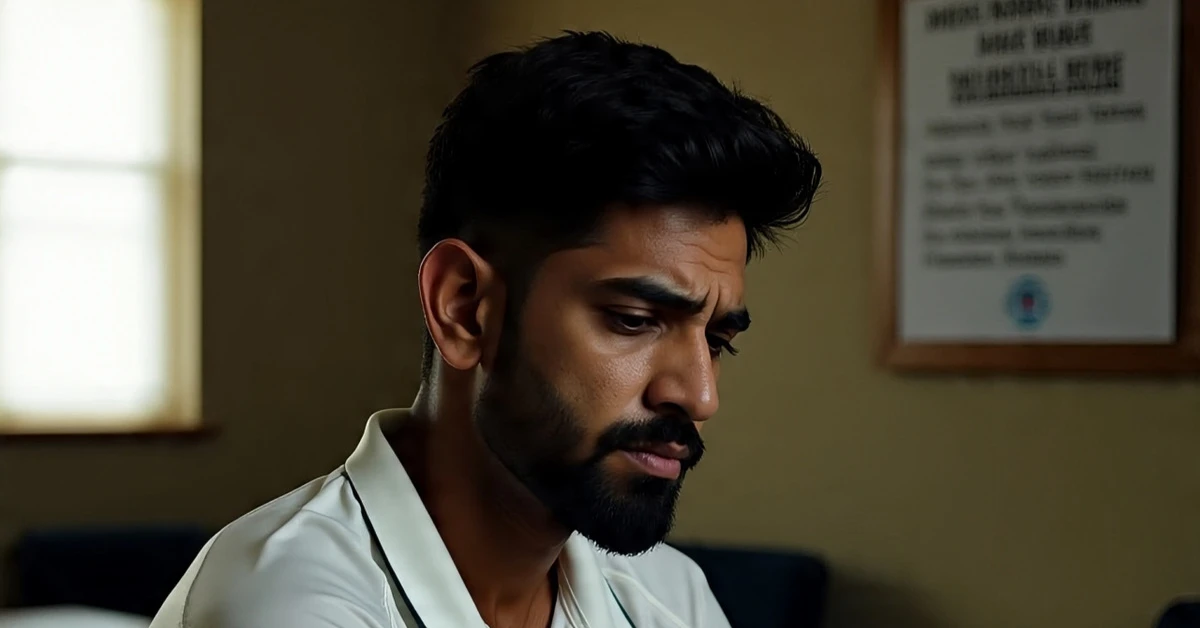Last Updated: August 8, 2025
Brian Lara vs Virat Kohli: The Prince and the King — A Deep Dive

Two batsmen. Two eras. One question: what separates a once-in-a-generation genius from a modern-day run-machine? This article compares Brian Lara and Virat Kohli across careers, technique, statistics, temperament, leadership, and legacy.
Introduction — Why this comparison matters
Cricket fans love debates. Brian Lara and Virat Kohli belong to that rare group of batsmen whose names instantly stir emotion, highlights and heated timelines. Lara is the romantic icon — flamboyant, record-smashing, and a player of singular moments. Kohli is modern perfection — relentless, driven, and statistically monstrous across formats. Comparing them helps us understand how batting excellence evolved from the late 20th century into the fully professionalized era of the 21st.
Career snapshots
Brian Lara — A left-handed West Indian who played international cricket between 1990 and 2007. Known for his monumental individual scores (including the world-record 501 in first-class and 400* in Tests), Lara combined timing, touch, and audacity. He finished his Test career with over 11,000 runs and 34 Test centuries — a record of consistency and big-innings temperament.
Virat Kohli — A modern right-handed Indian superstar whose international career began in 2008 and continued at elite levels through the 2010s and into the 2020s. Kohli has been a prolific run-scorer across formats with exceptional conversion rates of starts into hundreds, an intense fitness-driven approach, and a leadership record that includes captaincy stints across formats for India and captaining in high-pressure tournaments.
Was Brian Lara an all-rounder?
Short answer: No. Brian Lara was primarily a specialist top-order batsman. He did bowl very occasionally — listed in player profiles as a legbreak/googly bowler — and picked up a small number of wickets in first-class and international cricket. However, his bowling was part-time and not the basis for classifying him as an all-rounder. An all-rounder is typically a player who contributes regularly with both bat and ball; Lara’s main contribution to his teams was with the bat.
Statistics and records — apples and oranges?
Statistics matter — but context matters more. Lara's greatest feats include the highest individual Test score (400*), the highest first-class innings (501*), and multiple mammoth innings against world-class attacks in the pre-T20 commercial era. Kohli's career is defined by volumes: massive international run tallies across Tests, ODIs and T20Is, phenomenal averages in chases, and a high frequency of centuries and chases completed for his teams.
Format versatility
Lara played primarily Test and ODI cricket in an era where one-day cricket was dominant alongside traditional Tests; T20s arrived late in his career and he did not embed in the format the way modern players do. Kohli, however, emerged as a generational all-format player — strong in Tests, outright dominant in ODIs, and an elite T20 performer. For teams selecting based on multi-format value, Kohli represents a new benchmark.
Technique and temperament
Brian Lara had a defense built around balance and a front-foot dominance that allowed him to free his hands. His footwork and subtle use of the crease produced a wide range of scoring options; he relished long innings where concentration and rhythm unlocked monstrous scores.
Virat Kohli is the textbook modern batter: compact, athletic, with minimal technical flaws and a scanning approach to bowlers. Kohli’s running between the wickets, fitness, and shot selection — particularly under pressure and in chases — make him uniquely effective in modern limited-over cricket. His temperament mixes aggression with a relentless hunger for runs.
Signature innings — moments that define careers
Lara’s 400 not out (against England) and 501* for Warwickshire are innings that altered how records are perceived — streaks of concentration and audacity. Kohli’s signature knocks often come in run-chases and high-stakes games: match-winning centuries in World Cups and series-deciders where he shepherded the chase with surgical precision.
Captaincy and leadership
Lara had mixed results as a captain; his personal brilliance didn’t always translate into consistent West Indies dominance during his leadership years. Kohli’s captaincy era was transformational in terms of fitness, aggression and results in many formats — although leadership carried pressures and controversies that are part of modern cricket’s public life. Evaluating captaincy is as much about team-building and legacy as pure win–loss ratios.
Impact off the field
Lara is a cultural icon in the Caribbean and globally remembered for artistry, charisma and breaking long-standing records. Kohli’s impact is both cultural and commercial — raising fitness standards in India, attracting sponsorships, and becoming a global sporting brand. Both influenced generations: Lara inspired elegant strokeplay; Kohli inspired professionalism and fitness.
Who wins the head-to-head?
There’s no exact answer. Lara is the romantic choice — one who could (and did) produce innings that redefined possibility. Kohli is the statistical and situational choice — a relentless accumulator and clutch performer across formats. If you prefer cinematic, era-defining single innings, Lara is your pick. If you value volume, modern consistency across formats, and match-defining chases, Kohli takes it.
How the eras shape the debate
Comparisons must respect context: pitches, protective gear, bowling speeds, match frequency, fitness science, and the presence of T20 leagues. Lara’s era prioritized longer Red-Ball innings and fewer high-volume T20 leagues; Kohli’s era includes packed international schedules, franchise cricket and science-driven fitness regimes. Both adjusted to their times and excelled.
Practical uses — for writers, podcasters, and SEO
- Angle for a feature: ‘Lara’s Long Innings vs Kohli’s Marathon Seasons’.
- SEO keywords to target: Brian Lara vs Virat Kohli, Lara vs Kohli stats, greatest batsmen generations, Virat Kohli records.
- Suggested social post hook: ‘Prince of Port of Spain or King of Chases — who’s your GOAT?’
Conclusion
This isn’t a scoreboard verdict — it’s a portrait of two cricketing languages. Brian Lara wrote poetry in long passages; Virat Kohli architects victory with relentless, modern efficiency. Both are indispensable to cricket’s story; both deserve the pedestal reserved for the sport’s rare geniuses.
Frequently Asked Questions
1. Who scored more international runs: Brian Lara or Virat Kohli?
Virat Kohli has scored more total international runs across formats than Brian Lara, due to Kohli's long, multi-format career and the proliferation of matches in the modern era.
2. Who had the higher Test average?
Career averages depend on the cut-off date and can change for active players. Historically Lara held impressive Test numbers; Kohli’s Test average has been among the modern greats and varies by year. Check live stats sources for precise, date-stamped averages.
3. Which player is better in chases?
Kohli is widely regarded as one of the best chasers in limited-overs cricket; his record in successful run-chases is legendary. Lara played in a different era with fewer specialized chase situations.
4. Can you compare their records directly?
Yes — but do it with era context. Raw numbers alone miss pitch conditions, match frequency and format shifts. Use both per-innings metrics and era-adjusted context.
5. Which batsman changed how cricket is played?
Both did: Lara for style and the idea of single-innings enormity; Kohli for fitness, chase mentality and all-format excellence.
6. Was Brian Lara an all-rounder, batsman, or bowler?
Brian Lara was primarily a specialist batsman. While he bowled occasionally (legbreak/googly), his role in the team was almost entirely with the bat. He is not considered an all-rounder.
7. Was Virat Kohli an all-rounder, batsman, or bowler?
Virat Kohli is a specialist batsman. Although he has bowled a few overs in limited-overs cricket as a part-time medium pacer, his main role has always been batting, and he is not classified as an all-rounder.
You May Also Like:

UK Immigration Fraud Uncovered in Motherwell: A Deep Dive...

Virat Kohli’s Final Chapter: Why His 2025 Retirement Will Reshape Indian Cricket Forever...

Virat Kohli vs Cricket Legends: A Battle of Records Across Genders...

Why Most Businesses Fail and How to Avoid Common Mistakes (So You Don’t Fall into the Same Trap)...

Haris Rauf Banned for Two Matches After Asia Cup Clash — ICC Takes Strict Action...

Govinda: The King Who Lost His Crown – How Bollywood’s Funniest Superstar Vanished from the Big ...

Sachin vs Virat: A Detailed Comparison of Cricket’s Greatest Icons...

